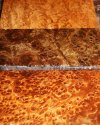You are using an out of date browser. It may not display this or other websites correctly.
You should upgrade or use an alternative browser.
You should upgrade or use an alternative browser.
Does burl wood need stabilizing?
- Thread starter kdnolin
- Start date
- Joined
- Dec 27, 2013
- Messages
- 2,654
Not all burl needs stabilizing, but I would highly recommend it for Maple or Walnut
- Joined
- Apr 17, 2018
- Messages
- 319
So when you stabilize a piece of wood do you stabilize the block that you're going to make the handle from before you make the handle. Or do you get the handle carve down close to finish size and then stabilized?
- Joined
- Jan 4, 2016
- Messages
- 5,346
Cut the block a little oversize. Make sure it is very, very dry and stabilize as a block. It will likely warp and twist a little in the stabilizing. Only shape AFTER stabilizing. After stabilizing you have to square it up and surface it to have parallel sides, then go about making your handle.
I recommend not even cutting it into slabs for scales until after stabilizing, but that's just my preference.
I recommend not even cutting it into slabs for scales until after stabilizing, but that's just my preference.
- Joined
- Jun 7, 2002
- Messages
- 3,408
I asked this question years ago. The primary answer was that burl soaked in water expands in all directions. Straight grain is better by a long shot.
Rose and Thistle Custom
Josh Mead
- Joined
- May 9, 2018
- Messages
- 2,301
Britt_Askew
Knifemaker / Craftsman / Service Provider
- Joined
- Dec 9, 2010
- Messages
- 1,211
Straight grain would be less likely to have problems but its boring compared to burl. If you put a piece of natural burl in water it will swell in all directions but stabilizing the burl makes water absorption much much much less of a problem.I asked this question years ago. The primary answer was that burl soaked in water expands in all directions. Straight grain is better by a long shot.
The way I see it is if the burl will take stabilization it should be stabilized.
- Joined
- Apr 17, 2018
- Messages
- 319
Do you guys think that the cactus juice, homemade stabilisation kit, is as good as a piece you get from a vendor?
Do you guys think that the cactus juice, homemade stabilisation kit, is as good as a piece you get from a vendor?
My opinion is that it depends on the wood and depends on the home stabilizer. As mentioned before, some woods will uptake the resin more easily than others, so you they may benefit less from the high pressures used by the big boys. On the other hand, what I've read is the big vendors use different formulation for different woods, something you don't get just using Cactus Juice, Gator Venom, or whatever other things are available commercially.
This set of burl scales was dyed and stabilized by one of the two big companies always recommended here on the forum. Wood can still move even when stabilized by the gold standard companies.

- Joined
- Dec 27, 2013
- Messages
- 2,654
Do you guys think that the cactus juice, homemade stabilisation kit, is as good as a piece you get from a vendor?
No. Its as simple as that.
Ive done many tests, ive bought pieces stabilized at home, and I have had well over 1000 pounds done by K&G. The simple fact is that I have yet to find anyone with a home set up who can match the quality and consistency I get from K&G. Part of it is equipment, but the major factor is expereince and knowledge. Brad has been doing this for a long time. He knows what he is doing, and he does it very well.
That is not to say stabilized wood is perfect. As the poster above me pointed out, stabilized wood can move. But you will get the best results either sending your wood to be professionally stabilized or by purchasing it from someone who does.
- Joined
- Jul 31, 2015
- Messages
- 3,118
I do my own stabilizing of maple and even I agree with this. Unless you have the patience, time and money to do it right, just send it out. I personally enjoy it, and I have a pretty steady supply of figured maple, so I do it. I also mess around with a lot of double and triple dyeing. Not something easy to spec to someone else. If I have a large quantity of something or if it's something I know can be problematic like walnut, I send it to k&g.No. Its as simple as that.
Ive done many tests, ive bought pieces stabilized at home, and I have had well over 1000 pounds done by K&G. The simple fact is that I have yet to find anyone with a home set up who can match the quality and consistency I get from K&G. Part of it is equipment, but the major factor is expereince and knowledge. Brad has been doing this for a long time. He knows what he is doing, and he does it very well.
That is not to say stabilized wood is perfect. As the poster above me pointed out, stabilized wood can move. But you will get the best results either sending your wood to be professionally stabilized or by purchasing it from someone who does.
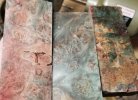
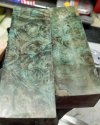
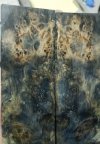
- Joined
- Apr 17, 2018
- Messages
- 319
Thank you guys so much for sharing.
I have access to lots ofmaple burl and some other very nice looking figured wood. I toss it under my deck and let it dry for a year or two. Then cut it up into blocks around 1x1.5x5ish when I need a batch. I send off about 30 block to K&G and it has run me about $180 shipping included to get them stabilized....around $6/block. That's a pretty incredible price for very nice maple burl blocks. Here is some maple burl and butternut that I got stabilized at K&G. Good price, no messing around, good quality.
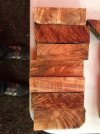
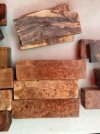


Last edited:
- Joined
- Jul 31, 2015
- Messages
- 3,118
On doing it yourself, it's much like being a hobbiest knife maker. Of course it's easier and usually cheaper to just buy a really nice knife. That's usually not the goal, as much as the process of making a knife is.

